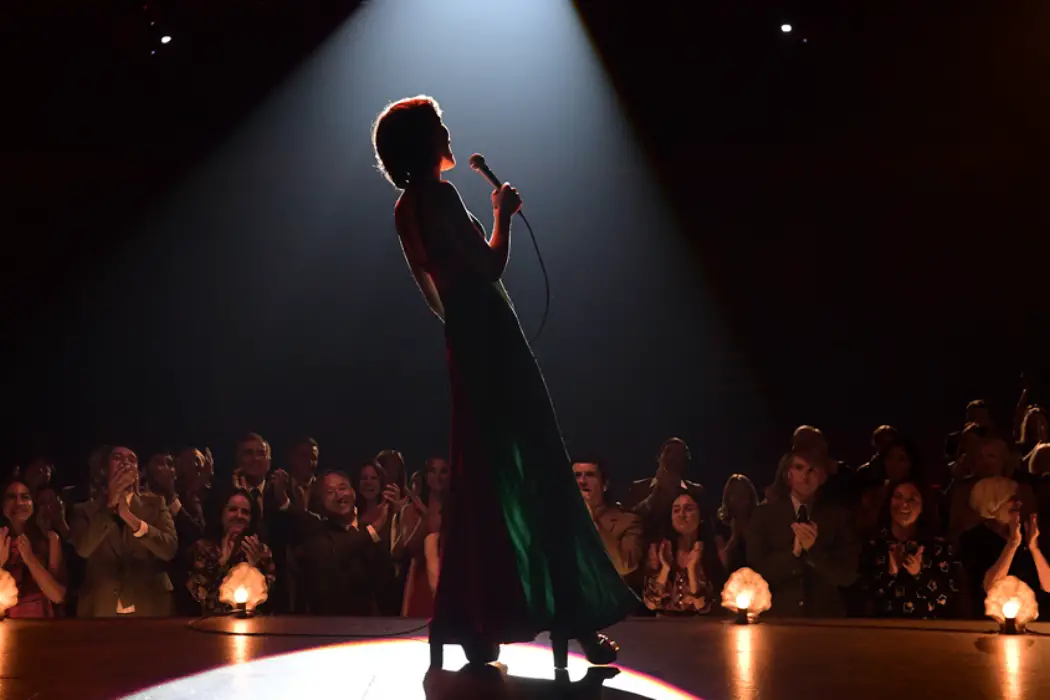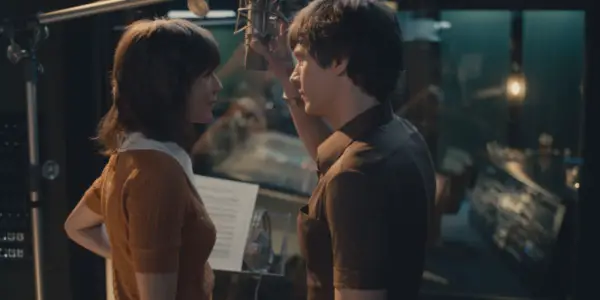I AM WOMAN: Woman’s Voice in a Man’s World

Ram is an independent film critic trying to combine his…
Emma Jensen’s screenplay spares no time in setting the rules of I Am Woman, directed by Unjoo Moon. Free of the childhood, teenage, and first broken relationship, the film directly begins with Helen Reddy (Tilda Cobham-Hervey) walking through a subway holding her 3-year old daughter, Tracy. Dressed in rosewood, a feminal color, while most men in black pass by, she walks up the stairs of the subway and emerges out of the dark interior. In the subway, we even catch sight of a ketchup advertisement that quotes the cartoon of a smiling lady flaunting a bottle, “Even I can open it” while the tagline reads “All new easy-open bottles”, pointing at the physical delicacy of women. Till now, it’s been less than a minute since we saw the first shot of the film and it has already captured the woman in a man’s world abstraction that the film entirely backs on. It speaks measures about the film’s politics, some directly, some implied, but the ideology is clear as a crystal from the word go.
This fervor of the film’s opening scene – created by Helen’s professional setbacks within 5 minutes – doesn’t sustain long, ascribed to a first act that goes every bit by the ‘book of biopics’. Then begins the second act, which we see coming from miles away, but alleviates the harm caused by the frail first act to a major extent. The path to arrive there, though, the wait for the story to begin, can be testing and that has a dual impact on the viewer.

On a level, you are waiting for the character’s life to move to the next phase – which assures that the film shifts gears subsequently – while also being an acknowledgment of the prevailing mundanity in Helen’s life. On that front, the first act, which is intentionally decelerated – 2 years spread over 40 minutes while the last one hour squeezes in over 20 years of progress – allows us to understand Helen and her developing relationship with Jeff Wald and the ups and downs, thereby adding complexity to the gender dynamics which the film has a clean eye for.
Profundity Amid a Multitude of Facets
With a screenplay that’s intended on giving a comprehensive account of Helen’s career, it has way too many facets to address and too little time to effectively do them. Nevertheless, the latter half, especially the last half hour, brings much-needed depth to the film. Helen’s relationship with her best-friend Lilian Roxon (Danielle Macdonald), and the gradual change, is what makes the character three dimensional and bestows the film’s most heart-warming and wrenching moments.
Furthermore, this is where the film breaks its long abided biopic-rule and allows us to see the flawed side of the subject, which until then is kept purely positive. However, her relationship with her children, the changing marriage dynamics, and more importantly, her evolution as a person, lacks the depth needed to create a strong emotional resonance, but it’s engaging, nonetheless. At a point, I wondered whether a 6-episode miniseries could have etched her character deeper.
A Man’s World
Each and every aspect of the world Unjoo Moon tries to reflect, is designed to reinforce the film’s core ideology – a woman, who is a symbol of many women, piercing through the men’s world. In one of the earlier portions, when she questions why she is paid less than the male members of the band, the club owner responds with “they have families to feed”, while herself is a single mother. It addresses the deeply imbibed gender conventions. Her song, “I Am Woman”, is initially termed ‘man-hating’ by a bunch of male music-label executives. Both her breakthrough and uneventful downfall are attributed to her troubling husband, Jeff Wald (Evan Peters). In a way, her entire career is shaped by the man in her life, which the film beautifully captures.

Not subtle, but staggering, invigorated by performances. As Helen, Cobham-Hervey balances the naivety in the initial half and the pride in the latter half, with an ever-lasting smile. Peters’ Jeff, though, is the tougher character here, even more than the biopic’s subject I’d say. Unlike Helen, whose trajectory is majorly linear, Jeff’s ambit is turbulent, and Peters brings the precise amount of innocence and obnoxious nature. Macdonald as Lilian Roxon, too, is very impactful with her character’s lovableness and a certain level of grief within the relatively lower screen time.
Conclusion: Energy Soars Despite Shortcomings
I Am Woman is certainly neither the greatest musical biopic nor the most intriguing account of a musician, but the energy soars during the musical set-pieces – equally aided by compelling performances and efficient world-building – and they succeed in transporting you to a time when everything was different, but little has changed since. As a film based on a musician’s life should be, I Am Women‘s reliance on music as a tool to further enhance the evident ideology is rewarding despite its pacing shortcomings.
What are your favorite musical biopics? Let us know in the comments below.
Watch I am Woman
Does content like this matter to you?
Become a Member and support film journalism. Unlock access to all of Film Inquiry`s great articles. Join a community of like-minded readers who are passionate about cinema - get access to our private members Network, give back to independent filmmakers, and more.
Ram is an independent film critic trying to combine his love for films and writing, to give readers something more than just an opinion.













